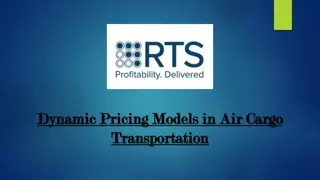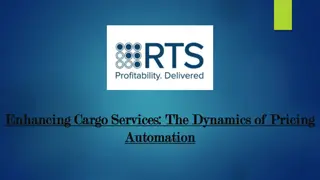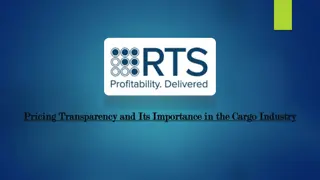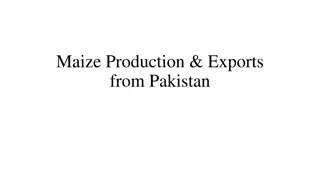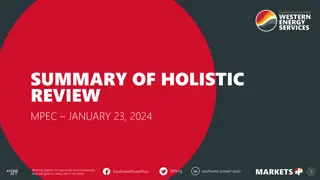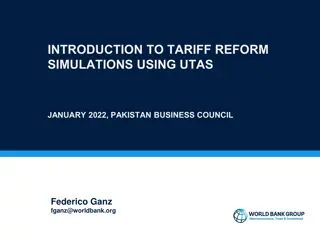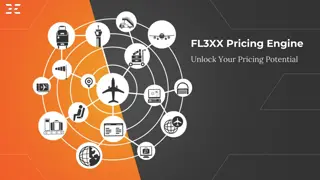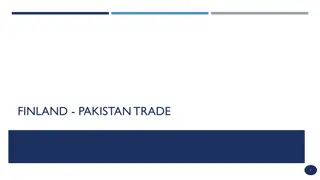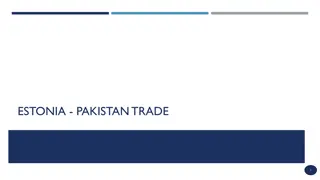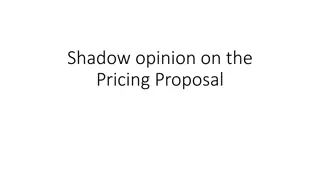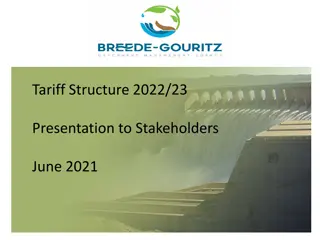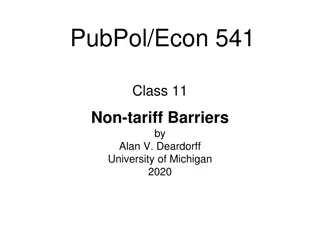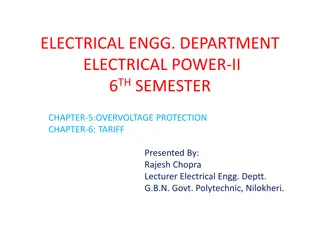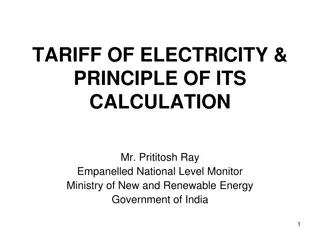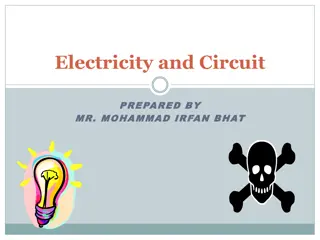Understanding Electricity Pricing and Tariff Structure in Pakistan
Electricity pricing involves costs of power plant operations and grid maintenance, impacted by factors like fuel cost, regulations, and consumer demand. Pakistan's tariff structure uses an incremental block tariff system to manage usage, with mechanisms set by regulators for fair pricing and affordability considerations.
Download Presentation

Please find below an Image/Link to download the presentation.
The content on the website is provided AS IS for your information and personal use only. It may not be sold, licensed, or shared on other websites without obtaining consent from the author. Download presentation by click this link. If you encounter any issues during the download, it is possible that the publisher has removed the file from their server.
E N D
Presentation Transcript
Electricity Pricing Mr. Shahid Sattar Executive Director, APTMA Former Member Energy, Planning Commission 1
What is electricity pricing? Electricity prices generally reflect the cost to build, finance, maintain, and operate power plants and the electricity grid. Due to the complications of electricity generation, the cost to supply electricity varies minute by minute in electricity markets. The worldwide acknowledged cardinal principle is that least cost/competitive electricity pricing only possible through multi-seller competitive sales of electricity to consumers at all levels. 2
Factors Determining The Price Cost Of Fuels Regulations Power Plant Cost Season Transmission & Distribution System Location Weather Type Of Consumer In developed markets, short-term prices are impacted the most by the weather. Demand due to heating in the winter and cooling in the summer are the main drivers for seasonal price spikes. 3
Electricity Tariff Structure In Pakistan For residential customers, Pakistan s electricity tariff This increasing IBT prices goes against the principle of bulk discounts & costs of service! adopts an incremental block tariff (IBT) structure, where a unit price increases in the amount of electricity use. There are many rationales for the IBT in Pakistan, but the main one is to protect lifeline (or extremely small) users. Pakistan is not marketing electricity (despite excess This also flouts the installed capacity), it is rationing the use of electricity universal access to through IBT and Revenue Based load shedding. power principle. 4
Pakistan - Mechanism For Setting Electricity Pricing? The price / tariff for Generation, Transmission and Distribution segments and setting of consumer end tariff is designed by regulator. Determination of consumer end tariff ideally, the regulator has to follow the following steps for proper rate making for each class of consumers; Revenue Requirement Cost of Service Rate Design Affordability What is each class s equitable share if utility revenue requirement? How rates should be adjusted to reflect cost of service remain sensitive to consumer rate impact? How many can manage to pay for it? How much is needed to meet the cost of providing electricity distribution service, including cost of capital. 5
Pakistan Adjustments in Tariff Annual adjustments in the rate to the following components; Assessment of T & D losses target. Assessment of Sales target. Impact of Consumer mix variance. Month wise assessment of reference values with respect to PPP (including energy, capacity & transmission charges) for the whole control period. Assessment of Distribution Margin. The system currently in vogue to unpredictable high levels of prices. System is also corrupted since NEPRA is holding government onus of determining cross-subsidy affecting the whole economy. Assessment of prior period assessment. Certain adjustments like impact of losses, variation in capacity transfer price and UoSC, impact of extra or lesser purchases of units are made on quarterly basis. Regulator shouldn t be controlling state s obligation! 6
Mechanism Opted In Other Countries For Setting Electricity Prices In standard regulated markets like the US, there are multilevel governance structures that set electricity rates. Rates are determined through a regulatory process that is overseen by Public Service Commission (PSC), which also regulate utility rates in each state. Electricity pricing is fundamentally governed by principles of Least Cost and competitive procurement at generation level and competitive selling at distribution level. 7
In the UK, some of the big household suppliers produce or generate a proportion of their own energy. But they buy most of it either direct from the producers who generated the power or sourced the gas, and the rest is bought from the traded wholesale markets. The UK suppliers are usually paying the price set by the traded market, where a variety of producers, utilities and speculators are active every day. Truly competitive markets (retail and wholesale) are driven by competition where players compete in the market for selling electricity, either short- or long- term without any pre-assurance from demand side. 8
There are broadly at least three approaches to tariff setting identifiable in the EU: 1. Average Historical Cost Approach 2. The Average Reproduction Cost 3. The Marginal Cost approach The purpose of setting methodologies across countries is based upon the fundamental principle of competitive price discovery all across the EU. 9
Rest Of The World In Liberia all customers pay the same price per kilowatt-hour (kWh), regardless of level of consumption or other attributes. In South Africa tariffs are differentiated by voltage levels, time of day, season, and customer category, and customers may pay fixed and demand charges as well as levies for cross-subsidization. The countries differ in how they incorporate the following features in their tariffs: Schedules for high-voltage customers Time-of-use pricing Demand charges Usually decreasing prices in each subsequent block as opposed to Pakistan s increasing level of tariffs. Sector-specific tariffs Block tariffs 10
India has divided the country in 5 regions; The total cost levied on the consumer is divided into three parts usually referred as 3 part tariff system, 1) Northern, 2) Southern, 1) Fixed cost, 3) Eastern, 2) Semi fixed cost, and 4) Western and 3) Variable cost. 5) Northeastern region. Within every state, they have an SLDC (State Load Dispatch distribution system is carried out by many distribution companies (DISCOMS) and SEBs (State Electricity Board). There are two tariff systems, one for the consumer which they pay to the DISCOMS and the other one is for the DISCOMS which they pay to the generating stations. 10% electricity is traded in India that has significantly brought down the prices in recent years. Center). The Increasing levels of B2B trades via wheeling has kept electricity competitive for industries. the cost of 11
Chinas electricity prices for industrial consumers depend upon the category of industry, type of electricity usage, and region where it is located. China s industrial power rates vary from region to region and are based on different voltage levels and transformer capacities. China charges electricity fees according to four types of electricity usage; 1) residential electricity, 2) agriculture production electricity, 3) general commercial and industrial electricity, and 4) large-scale industrial electricity. China s electricity grid is reliable and does not require the back-up power generation needed in other lower cost manufacturing destinations in Asia like India, Vietnam, Myanmar, and Cambodia Price determination is completely state controlled with special rates for export oriented sectors and special emphasis on affordability in less developed areas. 12
Electricity tariffs in Bangladesh are unbundled reflecting the current electricity supply market of the country. Three types of tariffs are in operation in Bangladesh: 1) Bulk or wholesale tariff - the rate at which Bangladesh Power Development Board (BPDB) purchases power from the generating entities. 2) Wheeling charges paid to PGCB have been kept affordable (B2B deals resulting in rapidly increasing market share). 3) Retail Tariff - the rate at which the distribution companies sell to consumers Continued 13
As a single buyer, BPDB procures power supply from IPPs, small independent power producers (SIPPs), rental power plants, corporatized generation companies and other publicly-owned power plants based on negotiated bulk power tariff rates. BPDB s bulk supply tariffs are function of fuel type, plant load factor and other parameters In return, BPDB sells electricity to distribution utilities based on Bangladesh Energy Regulatory Commission (BERC) regulated wholesale tariff rates. There is a huge buildup of subsidy in the system as a result of lower than cost wholesale tariffs. Power Grid Company of Bangladesh (PGCB) as the national grid operator is allowed to recover its costs through wheeling charges to distribution utilities. Wheeling charges are set by the government through executive orders. PGCB s wheeling rate has remained unchanged over the long term. 14
Canada: The wholesale price is dynamic, changing hourly based on the demand for electricity in Ontario and the availability of supply the methodology for determining price in Canada is; 1) Forecasting demand for electricity 2) Offers to supply and bids to purchase are submitted into the electricity market 3) Setting the market price where supply meets demand 4) Charging the wholesale price to large consumers The average of the twelve market clearing prices set in each hour is called the Hourly Ontario Energy Price, or HOEP. The HOEP is charged to large consumers that participate in the market, as well as local distribution companies (LDCs) who in turn recover it from business customers that pay the wholesale market price. Basic Principle Applicable is Competitive Pricing! 15
THANK YOU 16




